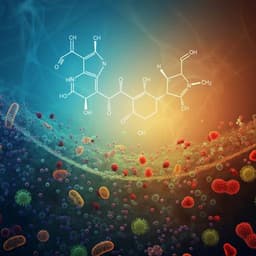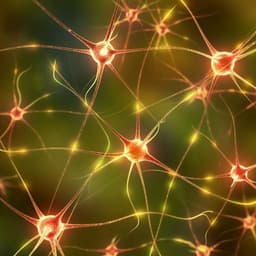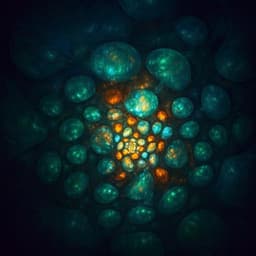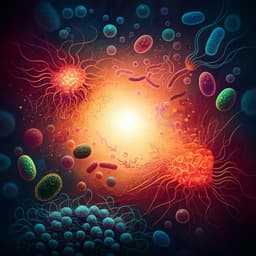
Medicine and Health
Gut microbiota changes require vagus nerve integrity to promote depressive-like behaviors in mice
E. Siopi, M. Galerne, et al.
This exciting study by Eleni Siopi and colleagues uncovers how the vagus nerve mediates stress-induced changes in the gut microbiome, influencing brain plasticity and behaviors associated with depression in mice. Their findings reveal that the vagus nerve's role is crucial in these processes, highlighting the gut-brain connection's impact on mental health.
~3 min • Beginner • English
Introduction
The study investigates whether chronic stress-induced alterations in the gut microbiome communicate to the brain via the vagus nerve (VN) to impair hippocampal (HPC) plasticity and promote depressive-like behaviors. Prior work shows the GM can modulate HPC plasticity and affective behaviors and that VN afferents link gut signals to brain regions influencing neurotransmission (e.g., BDNF, GABA receptor subunits). Chronic stress perturbs the GM and impairs adult HPC neurogenesis, contributing to depression. Given VN projections to brainstem serotonergic nuclei (e.g., dorsal raphe) that innervate the HPC, the authors hypothesize that GM perturbations from unpredictable chronic mild stress (UCMS) require VN integrity to alter neurotransmission, reduce HPC neurogenesis, and induce depressive-like behaviors.
Literature Review
Background evidence cited includes: GM regulation of HPC neurogenesis and serotonergic development; VN-dependent effects of specific bacterial strains on anxiety-like behavior and HPC gene expression; associations between chronic stress, GM dysbiosis, reduced HPC neurogenesis, and depression in rodents and humans; VN projections to serotonergic nuclei and effects of VN stimulation on HPC serotonergic input and affective behavior; links between neuroinflammation, altered monoamine availability, and depression; reports that VN stimulation modulates neuroinflammatory mediators and benefits treatment-resistant depression. These studies frame the GM–VN–brain axis as a plausible pathway for stress-induced behavioral and neurogenic changes.
Methodology
- Animals: Adult male C57BL/6J mice (8–10 weeks). Standard housing, 12h light/dark. Compliance with French/EU regulations. Power-calculated sample sizes: behavior (≥10/group), cellular (6–8/group), molecular (5/group). Total n=280 across six experimental sets with replication; randomization and blinded analyses employed.
- UCMS: Eight weeks of randomized mild stressors twice daily (e.g., cage shaking, tilt, moist bedding, overnight light, reversed light cycle, restraint, cage change, predator odors). Behavioral testing conducted in week 8; tissues collected at week 9.
- Antibiotics and fecal microbiota transfer (FMT): Broad-spectrum antibiotic cocktail in drinking water for 1 week (ampicillin 1 mg/ml, streptomycin 5 mg/ml, colistin 1 mg/ml, vancomycin 0.5 mg/ml, amphotericin 0.1 mg/ml). One day post-ABX, replaced with sterile water. Fresh feces from donor control (CT) or UCMS mice collected on inoculation day, suspended (1 mg feces in 5 ml PBS); 300 µl gavage administered 1 and 4 days after ABX discontinuation to recipient mice.
- Subdiaphragmatic vagotomy (Vx): Under ketamine/xylazine anesthesia, abdominal exposure of lower esophagus and stomach; ligature for retraction; dissection and transection of both vagal trunks and surrounding neural/connective tissue below diaphragm. Two-week recovery before FMT and behavioral testing.
- Experimental design: Donor CT vs UCMS cohorts; recipients: CT-tr vs UCMS-tr; sham vs Vx cohorts receiving CT or UCMS microbiota (CT-tr, UCMS-tr, CT-tr-Vx, UCMS-tr-Vx). Assessments at early time points (2–24 h post-FMT) and belated time points (3 and 7 weeks post-FMT).
- Behavioral assays: Open field, elevated plus maze, light/dark box (anxiety), sucrose preference (anhedonia), novelty suppressed feeding (latency to eat), tail suspension and forced swim tests (despair-like behavior). Animals acclimated ≥1 h; experimenters blinded; standard recording and analysis with EthoVision.
- Tissue collection: For immunofluorescence, perfusion with saline then 4% PFA; brains sectioned at 40 µm. For molecular assays, hippocampi dissected, snap-frozen at −80 °C.
- Immunostaining: Primary antibodies included anti-DCX, anti-Ki67, anti-c-Fos; Alexa-conjugated secondaries; Hoechst nuclear stain. Confocal imaging (Zeiss LSM 710); Z-stacks; cell counts in 8–10 sections/animal using Icy or manual methods.
- Western blotting: RIPA lysates; SDS-PAGE and PVDF transfer; probed for c-Fos, COX2, CREB, phospho-CREB, Cx3cr1, DCX, Iba1, IL-1β, IL-6, Ki67, Sox2, TGFβ1, TNFα; HRP-conjugated secondaries; chemiluminescence detection; Image Lab quantification.
- RT-qPCR: RNA extraction, cDNA synthesis; SYBR Green detection on ViiA 7. Targets: Th, Tph2, Ddc, GluR1, Gls1, Gls2, Grid1, Gad1, Gad2, Gabra2, Gabrb2, Bdnf, Foxo. 2^ΔΔCt analysis; triplicates.
- Microbiota profiling: Fecal DNA extraction (QIAamp DNA Stool Mini Kit with bead beating). PCR amplification of 16S rRNA V3 region; DGGE profiles analyzed in Bionumerics. 16S amplicon sequencing analyzed with MASQUE pipeline; OTUs annotated; negative log expression values computed; PCoA (Canberra distance), relative abundance plots, Shannon diversity; MATLAB scripts and Prism for statistics.
- Statistics: Data as mean ± SEM; GraphPad Prism 9; Mann–Whitney tests, two-way RM ANOVA with Bonferroni when appropriate; PCoA assessed by PERMANOVA; ROUT outlier exclusion; p<0.05 significance.
Key Findings
- VN activation by UCMS-derived microbiota: c-Fos immunoreactivity increased in nucleus tractus solitarius (NTS) at 2 h and sustained up to 24 h post-inoculation; cfos mRNA increased in brainstem.
- Brainstem neurotransmission gene changes after UCMS microbiota:
- At 4 h: Increased Tph2 (p=0.03, U=2); decreased Gls2 (p=0.008, U=0) and Grid1 (p=0.01, U=1); Th, Ddc, GluR1 not significantly changed.
- At 24 h: Decreased Th (p=0.01, U=0) and Ddc (p=0.01, U=1); increased GluR1 (p=0.01, U=0); Tph2, Gls2, Grid1 not significantly different.
- Hippocampal rapid responses:
- Increased c-Fos+ cells in dentate gyrus (DG) at 2 h (p=0.008, U=0) and 24 h (p=0.008, U=0) post-inoculation; increased c-Fos protein by Western blot.
- Decreased DCX+ immature neurons at 24 h (p=0.03, U=35); no c-Fos/DCX co-localization, implicating preexisting neurons.
- Hippocampal gene/protein changes at 24 h: Decreased Th (p=0.05, U=2) and Ddc (p=0.008, U=0); decreased GluR1 (p=0.008, U=0); increased Gls1 (p=0.03, U=1). Reduced CREB protein (p=0.02, U=0), and reduced Bdnf (p=0.05, U=3) and Foxo (p=0.02, U=0) mRNA.
- Behavioral phenocopy in recipients of UCMS microbiota:
- Sucrose preference decreased in donors (CT vs UCMS: p=0.0005, U=7.5) and recipients (CT-tr vs UCMS-tr: p=0.01, U=16).
- Novelty suppressed feeding: Increased latency in donors (p<0.0001, U=2.5) and recipients (p=0.05, U=24).
- Tail suspension and forced swim: Donors displayed increased immobility (TST p=0.02, U=20.5; FST p=0.0007, U=8). Recipients: TST increased at 7 weeks (p=0.03, U=21) but not at 3 weeks (p=0.48, U=40); FST increased at 3 weeks (p=0.0001, U=4.5) and 7 weeks (p=0.002, U=10.5).
- Adult neurogenesis deficits: Reduced DG DCX+ cells in donors (p=0.002, U=0) and recipients (p=0.004, U=1).
- Microbiome confirmation: PCoA showed distinct clustering of CT vs UCMS donors and corresponding recipients (PC1 23.4%, PC2 14.9%; PERMANOVA p<0.001). Taxonomic shifts at family and phylum levels and altered Shannon diversity confirmed UCMS-induced dysbiosis and successful transfer.
- Vagotomy prevents GM-induced effects:
- Behavior: Vx abrogated decreases in sucrose preference (UCMS-tr vs UCMS-tr-Vx p=0.04, U=22.5); prevented increased NSF latency (p=0.005, U=6); reduced immobility in TST and FST at both 3 and 7 weeks (e.g., FST 3 weeks p<0.0001, U=2; 7 weeks p=0.003, U=4). Sham UCMS-tr showed strong depressive-like responses (e.g., TST at 7 weeks p=0.0002, U=0).
- Neurogenesis: Vx protected from decreases in DG Ki67+ proliferating cells (CT-tr vs UCMS-tr p=0.004, U=1) and DCX+ neurons (p=0.001, U=3).
- Neuroinflammation is early and sustained and VN-dependent:
- At 24 h, hippocampal TNFα, IL-1β, IL-6 proteins increased in UCMS-tr.
- At 7 weeks, increased Cx3cr1 (microglial marker) and a trend to increased COX2; decreased pro-neurogenic TGFβ.
- In Vx recipients, no differences in these inflammatory markers at 24 h or 7 weeks, indicating VN integrity is necessary for GM-induced neuroinflammation.
Discussion
The findings demonstrate that chronic stress-induced gut microbiota perturbations signal via the vagus nerve to rapidly affect brainstem and hippocampal neurotransmission, trigger neuroinflammation, impair adult hippocampal neurogenesis, and induce depressive-like behaviors. Early decreases in rate-limiting enzymes for dopamine and serotonin (Th, Ddc) in brainstem and hippocampus, alongside reduced neurogenic factors (CREB, Bdnf, Foxo), provide a mechanistic link between VN activation and diminished hippocampal plasticity. Behavioral assays show that UCMS-derived GM is sufficient to transfer anhedonia, anxiety-/despair-like behaviors, and neurogenesis deficits to healthy hosts, while subdiaphragmatic vagotomy abolishes these effects, establishing VN integrity as necessary for GM-driven behavioral and cellular phenotypes. Sustained neuroinflammation (elevated TNFα, IL-1β, IL-6; increased Cx3cr1; reduced TGFβ) aligns with known interactions between inflammation, monoaminergic dysregulation, and impaired neurogenesis in depression. These results support the GM–VN–brain pathway as a key regulator of affective state and hippocampal plasticity, and suggest therapeutic leverage via microbiome modulation or VN-targeted interventions (e.g., VNS).
Conclusion
Chronic stress reshapes the gut microbiome to produce signals that require an intact vagus nerve to alter brainstem and hippocampal neurotransmission, induce hippocampal neuroinflammation, reduce adult hippocampal neurogenesis, and promote depressive-like behaviors. Subdiaphragmatic vagotomy prevents these GM-induced effects, establishing VN afferents as essential mediators of the GM–brain interaction in this context. This work advances understanding of the mechanisms linking stress, gut dysbiosis, and depression, and highlights potential therapeutic strategies targeting the microbiome and vagal pathways. Future studies should identify specific microbial taxa and metabolites responsible for VN activation, map the precise gut–NTS–septum–hippocampus circuits using modern circuit-tracing and neuromodulation tools, and integrate multi-omics (metatranscriptomics, metabolomics, lipidomics, proteomics) to define molecular mediators.
Limitations
- The study does not identify specific bacterial strains or metabolites driving VN-mediated effects.
- Subdiaphragmatic vagotomy is a nonselective intervention; selective, reversible modulation of VN afferents (e.g., opto-/chemogenetics) would provide more precise causal evidence.
- The work focuses on the hippocampus; effects on other neurogenic niches (e.g., subventricular zone) and associated functions (e.g., olfaction) were not assessed.
- Not all microbiota–brain signals are VN-dependent; alternative pathways (immune routes, microbial metabolites) may contribute and were not dissected here.
Related Publications
Explore these studies to deepen your understanding of the subject.







